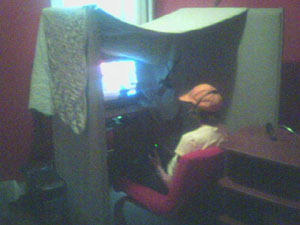This interview with McKenzie Wark was conducted inside an online version of the Halo 2 video game as part of the upcoming fourth episode of This Spartan Life, “a talk show in gamespace.” Many thanks to Chris Burke and the TSL team for doing such a fantastic job. Click the image to play (it’s a little under 14 minutes):
From the interview, here’s McKenzie on collaborating with readers inside his book:
“It sort of brings out what writing always is anyway, which is that, in a sense, you’re always the DJ of other people’s thoughts and ideas, and this just makes that manifest.”
Also see this interesting thread in the GAM3R 7H30RY forum from a while back — a discussion between McKenzie and Chris about “glitching” and other forms of trifling or hacking within the game (the bread and butter of machinima filmmakers), and whether this can lead to real freedom. There’s a moment later on in the video where the debate gets wonderfully concretized in the physical landscape of the game world.
We “shot” the footage back in August at Chris’s studio in Brooklyn. I managed to snap a couple of hazy pictures with my camera phone:


On the left you see the room where Chris and the two camera operators have their consoles. On the right is McKenzie in his own little cave. Everything is recorded through video feeds running out of the Xboxes. Ken and Chris talk over headsets and move around the game environment while the two “cameras” follow behind (the cameras are just the perspectives of the other two gamers). The chaos during Ken’s reading at the end is the work of other online gamers from around the country — TSL groupies who like helping out with shoots and generally raising hell. Seeing Chris try to coordinate this rambunctious crew long distance was highly entertaining.
(If you haven’t seen it, also check out This Spartan Life’s interview with Bob from their first episode. A real treat.)


